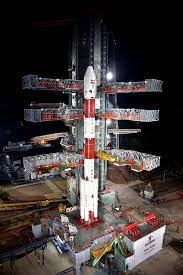Aditya L1
About
Chandrayaan Missions
Aditya L1
Aryabhata
INSAT
GSAT
MOM
Astrosat
Gaganyaan
Aditya-L1 solar mission by the Indian Space Research Organisation (ISRO) aimed at studying the Sun's corona and chromosphere. The mission has launched in 2023 and will place a spacecraft in a halo orbit around the Sun-Earth Lagrange point 1 (L1), located about 1.5 million kilometers from Earth.

Spacecraft
The Aditya-L1 spacecraft will be a 1,500 kg spacecraft carrying seven scientific payloads:
- Visible Emission Line Coronagraph (VELC): This instrument will image the Sun's corona in visible light.
- Solar Ultraviolet Imaging Telescope (SUIT): This instrument will image the Sun's chromosphere and corona in ultraviolet light.
- Aditya-L1 Plasma Analyzer (APL): This instrument will measure the properties of the solar wind.
- Particle Environment Package (PEP): This instrument will measure the properties of energetic particles in the solar wind.
- Magnetometer: This instrument will measure the magnetic field in the vicinity of the spacecraft.
- Energetic X-ray Spectrometer (EXS): This instrument will measure the intensity and spectrum of X-rays from the Sun.
- High Energy L1 Orbiting X-ray Spectrometer (HEL1OS): This instrument will measure the intensity and spectrum of X-rays from solar flares.
Mission objectives
The primary objective of the Aditya-L1 mission is to study the Sun's corona and chromosphere. The mission will investigate a number of key questions about the Sun, including:
- How is the corona heated to temperatures of millions of degrees Celsius?
- What is the mechanism that accelerates the solar wind?
- How do solar flares and coronal mass ejections (CMEs) erupt from the Sun?
- What is the impact of solar activity on the Earth's environment?
Significance
The Aditya-L1 mission will be the first dedicated solar mission from India. The mission will make significant contributions to our understanding of the Sun and its impact on the Earth. The data collected by the mission will be used to develop better models of the Sun and to improve our ability to predict solar storms.
Launch and operations
The Aditya-L1 mission is scheduled to launch in 2023. The spacecraft will be launched into a low Earth orbit by a Polar Satellite Launch Vehicle (PSLV). The spacecraft will then use its own propulsion system to travel to the L1 point. Once in orbit, the spacecraft will begin its scientific observations. The mission is expected to last for at least one year.
Home
Chandrayaan Missions
Aditya L1
Aryabhata
INSAT
GSAT
MOM
Astrosat
Gaganyaan
Gaganyaan
